
Concept explainers
Interpretation:
The fraction of
Concept introduction:
- Balanced chemical equation of a reaction is written according to law of conservation of mass.
- Equation for Number of moles of a substance, from its given mass is,
- Mole ratio between the reactant and a product of a reaction are depends upon the coefficients of reactant and product in a balanced chemical equation.
Answer to Problem 3.111QP
The fraction of
Explanation of Solution
In given reaction,
Mixture of
Therefore,
The chemical equation for this reaction is,
Balanced chemical equation of a reaction is written according to law of conservation of mass.
Therefore,
The total number of each atoms in the reactant side should equal to the total number of each atoms in the product side.
So, in order to balance a chemical equation, the coefficients of compounds or atoms are needed to be changed in such a way that total number of each atoms in the reactant side and the total number of each atoms in the product side is to become equal.
Hence,
The balanced equations for the given reactions are,
Assumes mass of
The mass of Mixture of
Let’s take mass of
So, the number of moles of
The balanced chemical equation of the reaction is,
The mole ratio between
The mole ratio between
So, the number of moles of
Then,
The mass of
The mass of
The mass of Mixture of
Let’s take mass of
So, the number of moles of
The balanced chemical equation of the reaction is,
The mole ratio between
The mole ratio between
So, the number of moles of
Then,
The mass of
The mass of
The mass of
The mass of
The mass of
The mass of
The total mass of
Therefore,
So, the mass of
Hence,
The fraction of
The fraction of
Want to see more full solutions like this?
Chapter 3 Solutions
Loose Leaf Version for Chemistry
 ChemistryChemistryISBN:9781305957404Author:Steven S. Zumdahl, Susan A. Zumdahl, Donald J. DeCostePublisher:Cengage Learning
ChemistryChemistryISBN:9781305957404Author:Steven S. Zumdahl, Susan A. Zumdahl, Donald J. DeCostePublisher:Cengage Learning ChemistryChemistryISBN:9781259911156Author:Raymond Chang Dr., Jason Overby ProfessorPublisher:McGraw-Hill Education
ChemistryChemistryISBN:9781259911156Author:Raymond Chang Dr., Jason Overby ProfessorPublisher:McGraw-Hill Education Principles of Instrumental AnalysisChemistryISBN:9781305577213Author:Douglas A. Skoog, F. James Holler, Stanley R. CrouchPublisher:Cengage Learning
Principles of Instrumental AnalysisChemistryISBN:9781305577213Author:Douglas A. Skoog, F. James Holler, Stanley R. CrouchPublisher:Cengage Learning Organic ChemistryChemistryISBN:9780078021558Author:Janice Gorzynski Smith Dr.Publisher:McGraw-Hill Education
Organic ChemistryChemistryISBN:9780078021558Author:Janice Gorzynski Smith Dr.Publisher:McGraw-Hill Education Chemistry: Principles and ReactionsChemistryISBN:9781305079373Author:William L. Masterton, Cecile N. HurleyPublisher:Cengage Learning
Chemistry: Principles and ReactionsChemistryISBN:9781305079373Author:William L. Masterton, Cecile N. HurleyPublisher:Cengage Learning Elementary Principles of Chemical Processes, Bind...ChemistryISBN:9781118431221Author:Richard M. Felder, Ronald W. Rousseau, Lisa G. BullardPublisher:WILEY
Elementary Principles of Chemical Processes, Bind...ChemistryISBN:9781118431221Author:Richard M. Felder, Ronald W. Rousseau, Lisa G. BullardPublisher:WILEY





